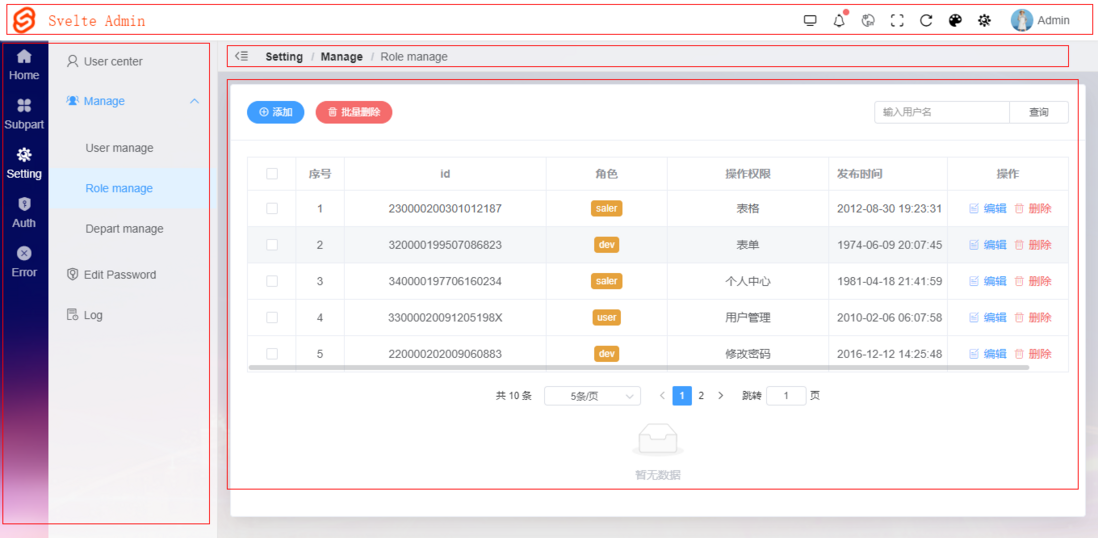1. Introduction
The new front-end framework of svelte.js is very popular, but there are relatively few component libraries and back-end systems developed by svelte.js on the Internet. So I developed a svelte-ui component library and svelte-admin background management system by myself.
Svelte Ui Admin is a middle and background management based on svelte3.x+svelteKit+svelte-ui+sass+mockjs and other technologies.
2. Technical realization
- Development tools: Vscode
- Technical framework: svelte3.x+svelteKit+vite3
- UI component library: svelte-ui (custom pc-side UI component library based on svelte)
- Chart component: echarts^5.3.3
- Graphic editor: wangeditor^4.7.15
- Internationalization scheme: svelte-i18n^3.4.0
- Data mock: mockjs^1.1.0
svelte-admin Support dynamic skinning, Chinese/English/Traditional international languages.
Directory Structure
Svelte-Ui component library
All components in the project follow the svelte-ui component library. The overall style is unified and beautiful.
svelte-ui desktop pc UI component library
public layout template
svelte-admin The whole is divided into three modules: top navigation bar + left dynamic routing menu + right main content area.
<div class="svadmin__container" style="--themeSkin: {$skin}">
<div class="svadmin__wrapper-layout flexbox flex-col">
<div class="sv__layout-header">
<Header />
</div>
<div class="sv__layout-body flex1 flexbox">
<!-- //侧边栏 -->
{#if rootRouteEnable}
<div class="sv__bd-sidebar">
<SideMenu routes={mainRoutes} {activeRoute} />
</div>
{/if}
{#if (rootRouteEnable && route != '/') || !rootRouteEnable}
<div class="sv__bd-menus" class:collapsed={collapsed&&!rootRouteEnable}>
<RouteMenu
routes={getAllRoutes}
{activeRoute}
{activeRootRoute}
{rootRouteEnable}
{collapsed}
/>
</div>
{/if}
<div class="sv__bd-main flex1 flexbox flex-col">
<!-- 面包屑导航 -->
<BreadCrumb routes={getAllRoutes} {activeRoute} {activeRootRoute} />
<!-- 主内容区 -->
<Scrollbar autohide gap={2}>
<div class="sv__main-wrapper">
<slot />
</div>
</Scrollbar>
</div>
</div>
</div>
</div>+error.svelte error handling
<script>
import { page } from '$app/stores'
import { goto } from '$app/navigation'
import { Button } from '$lib/svelte-ui'
function goHome() {
goto('/home/index')
}
</script>
<svelte:head>
<title>{$page.status} Error!</title>
</svelte:head>
<div class="svadmin__pageErr flexbox flex-col flex-alignc flex-justifyc">
<div class="svadmin__pageErr-img"><i class="sv-icon-round_close_fill_light"></i></div>
<div class="svadmin__pageErr-content">
<div class="c-red fs-18">┗| {$page.status} |┛ Page Error~~</div>
<div class="c-999 mt-10 mb-10">{$page.error.message}</div>
<Button size="small" on:click={goHome}>Go Home</Button>
</div>
</div>svelte-i18n internationalization
Project routing menus and pages support dynamic configuration of Chinese, English/Traditional languages.
npm i svelte-i18n /**
* 国际化语言配置
* @author YXY
*/
import { addMessages, init, getLocaleFromNavigator } from 'svelte-i18n'
import { browser } from '$app/env'
import Storage from '@/utils/storage'
// 引入语言配置
import cn from '@/locale/zh-CN'
import tw from '@/locale/zh-TW'
import en from '@/locale/en-US'
export const langKey = 'lang'
export const langVal = 'cn'
addMessages('cn', cn)
addMessages('tw', tw)
addMessages('en', en)
const lang = getLang()
console.log('当前国际化:', lang)
init({
fallbackLocale: lang,
initialLocale: getLocaleFromNavigator()
})
setHtmlLang(lang)
/* 获取语言 */
export function getLang() {
const lang = Storage.get(langKey)
return lang || langVal
}
/* 持久化存储 */
export function setLang(lang, reload = false) {
if(lang != getLang()) {
Storage.set(langKey, lang || '')
setHtmlLang(lang)
// 重载页面
if(reload) {
window.location.reload()
}
}
}svelte dynamic chart configuration
In order to solve the problem of using charts in multiple places, a new chart hooks file is created.
/**
* @title 动态图表Hooks
* @author YXY
*/
import * as echarts from 'echarts'
import elementResizeDetector from "element-resize-detector"
import utils from '@/utils'
export const useCharts = async(node, options) => {
let chartInstance
let chartNode = null
let erd = elementResizeDetector()
const resizeFn = utils.debounce(() => {
chartInstance.resize()
}, 100)
if(node) {
chartInstance = echarts.init(node)
chartInstance.setOption(options)
chartNode = chartInstance
}
erd.listenTo(node, resizeFn)
}Well, based on svlete-ui development background management system, I will share so much first. We will share some example projects in the future.
https://segmentfault.com/a/1190000041845857
https://segmentfault.com/a/1190000041357547























**粗体** _斜体_ [链接](http://example.com) `代码` - 列表 > 引用。你还可以使用@来通知其他用户。